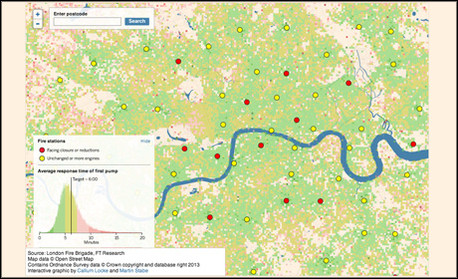
The creation of compelling and engaging graphic representations of stories has become an important part of any large news organisation's output.
Which is why the Financial Times has recently struck a deal with MapBox, a platform for creating custom maps.
"As a global news organisation we have to be prepared for the eventuality of having an event happen pretty much anywhere in the world," Martin Stabe, head of interactive news at the Financial Times, told Journalism.co.uk. "It's been a long time ambition of ours to be able to quickly produce web-based maps of any location in the world."
Stabe and his interactive team had previously been using MapBox's open source design studio TileMill to generate the graphics used in maps for the website, such as February's "How fast is the London Fire Brigade?". Using data obtained under the Freedom of Information Act, the Financial Times plotted the response times of fire engines to incidents across the capital in a grid of 251,498 100m-square tiles on six levels of zoomable scale.

Screenshot of the London fire map from FT.com
"The fire map gave us a sense of what a massive undertaking it would have been to try to build and develop this ourselves," Stabe said. "Scaling that up to the whole world would have been really prohibitive to us in terms of the resources we would have had to have dedicated to it.
"So at that point a hosted solution really became necessary and since we were already familiar with the processes and tools that MapBox provide they seemed like an obvious choice."
The ability to provide large maps that can quickly scale between orbiting overview and street level has been made possible by MapBox's new Vector tiles format, which fetches tiles quickly and applies customisable styles as the image is rendered, according to Alex Barth, head of data at MapBox.
"We're talking about having a map of the entire world down to street level, that's number one," Barth told Journalism.co.uk. "Number two is we're talking about a map that is hosted in a way so it can scale to read massive traffic that you'll want to serve as a newspaper or a popular social media service or something similar."
MapBox uses data from OpenStreetMap, the "Wikipedia of maps" said Barth, before adding their own mapping data to create the database that can be drawn on by registered users. For the Financial Times, the MapBox team adapted the base layer using the style guide which already existed for the FT print maps.
"The level of control that we just gave the Financial Times is something that we only do for select partners right now but it will be rolled out for everybody who has a MapBox account over the remainder of the year," continued Barth. "While we have the ability to have a much larger degree of customisation on our maps we still have to expose the right kinds of user interface to our clients so that it's easy to do."
For the Financial times, this means they now have a pre-existing base layer of maps for the entire world that is congruent with the house style and can be put to use for simple, static maps as well as zoomable interactives.
"If a news event happens in some part of the world that we haven't previously made a map for, then generating a quick turn around, temporary version – a locator map to tell people where an event took place – will become a much quicker thing to do," Stabe said.
When it comes to building the graphics on top, the Financial Times's interactive team typically use the Leaflet JavaScript library, said Stabe, or a tool like CartoDB which can generate tiles based on the input data. But, said Barth, creating such graphics is not "computer rocket science".
"It's going to require a little bit of programming and HTML skills but not an expensive back-end server or payments to MapBox to make that interactive layer happen," he said. "These are skills that any newsroom can pick up today and should have."
Free daily newsletter
If you like our news and feature articles, you can sign up to receive our free daily (Mon-Fri) email newsletter (mobile friendly).
Related articles
- 200 speakers you need at your next journalism event to avoid all-male panels
- Five key takeaways from the UK select committee on the future of news
- From Reuters to The New York Times, Big Oil pays 'most trusted media brands' to push greenwashing
- How the Financial Times is broadening its portfolio
- Why newsroom transformation is key to subscription growth









